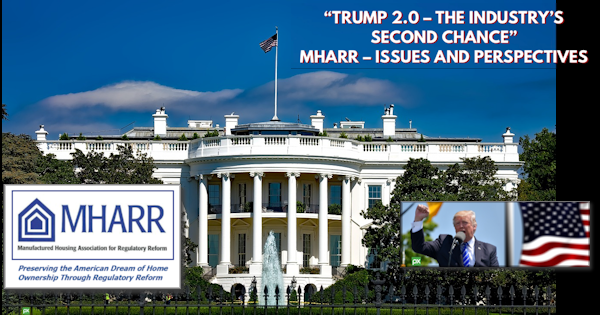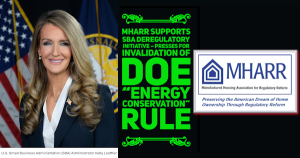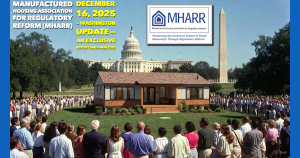
“TRUMP 2.0 – THE INDUSTRY’S SECOND CHANCE”
MHARR – ISSUES and PERSPECTIVES
By Mark Weiss | JANUARY 2025
Life does not always offer second chances. When it does, those fortunate enough to have that opportunity had better make the best of it. Failure, as the saying goes, is not an option.
Such is the case for the manufactured housing industry and its position in Washington, D.C., particularly with respect to federal regulation, the availability of affordable, mainstream manufactured housing for all Americans including, most importantly, reasonable state and local zoning laws, as well as federal consumer financing support for all qualified manufactured homebuyers.
When Donald Trump was elected President in 2016, the industry – then suffering from years of lagging production and looming draconian “energy” standards – was presented with an unparalleled opportunity. While unexpected by the pollsters and the usual suspects in the corporate media, that electoral victory brought into office an administration that was fundamentally premised on reducing regulatory burdens and costs, and empowering American industry to produce and compete at unprecedented levels.
In short order thereafter, the Trump Administration, fulfilling an early request by MHARR, withdrew the then-pending U.S. Department of Energy (DOE) proposed manufactured housing “energy” standards rule. It also took strong action on MHARR’s initiative to reform the leadership of the federal manufactured housing program, leading to a new program administrator. After those key actions, it then solicited broader comments at both DOE and the U.S. Department of Housing and Urban Development (HUD) to identify other regulations that could/should be withdrawn or terminated.
In each instance, MHARR submitted extensive comments, seeking the complete withdrawal, not only of the DOE energy rulemaking, but also elements of the HUD manufactured housing regulations that were either outdated or needlessly punitive. Simultaneously, MHARR held extensive meetings with Administration officials to press for the federal preemption of exclusionary zoning edicts that bar manufactured homes from too many areas of the country, and to promote and advance federal support for manufactured home consumer lending via the “Duty to Serve Underserved Markets” (DTS) mandate. Put simply, MHARR dedicated all four years of the first Trump Administration to exerting “maximum pressure” for reasonable federal regulation of the industry as well as more robust federal action to support the availability and utilization of inherently affordable HUD Code homes as prescribed by federal law, and eliminate the principal bottlenecks to such greater availability and utilization.
Thus, in accordance with its role as the industry’s regulatory “watchdog” organization in the nation’s capital — rather than a run-of-the-mill “trade association” — MHARR was at that time (and as it always has been) laser-focused on:
- (1) regulatory burdens and related costs, and alleviating those burdens to the maximum extent possible, consistent with both existing law and proper consumer protection and safety; and
- (2) providing opportunities for homeownership by promoting the greater availability of affordable, mainstream manufactured housing through elimination of the principal bottlenecks and barriers to full market participation, consistent, again, with existing law.
And again, the first Trump Administration offered a prime opportunity to achieve those crucial goals and once again expand industry production into hundreds-of-thousands of homes each year – where they rightly should be at a time when the affordable housing supply is (and has been) millions of units below existing demand.
Unfortunately, though, the broader industry did not share this intense and aggressive regulatory and opportunity-oriented focus (and still does not). To be sure, the broader industry and its representation in Washington, D.C., the Manufactured Housing Institute (MHI), went through all the motions – submitting comments and testimony and the like – but when it came to exerting the influence of the industry’s largest corporate conglomerates and the millions in dues raked-in from others along for the ride, the results produced were more a matter of “show” than actual substance. Thus, when it could have counted the most, the broader industry was (and still is) largely missing in action (i.e., not utilizing all means available as the organization collecting the largest representation dues from the industry’s post-production sector).
For example, there were manufactured homes (from the largest manufacturers, naturally) featured at the HUD “Innovative Housing Showcase” pioneered by Trump Administration HUD Secretary Ben Carson. And Mr. Carson even addressed MHI’s “Congress and Expo.” But to what end? There were glowing words and praise. But, without sufficient pressure from the entire industry, including MHI, for genuine reform (i.e., using all available means to compel HUD to fully and properly implement the enhanced federal preemption of the 2000 Reform Law, 42 U.S.C. 5403(d)) , it became a matter of promises made, but not kept. In the end, notwithstanding the talk and the promises, the only regulatory changes – if they could even be called that – were the withdrawal of unofficial regulatory commentaries offered by a former HUD program administrator in a series of newsletters.
Thus, at the conclusion of Trump 1.0, the industry remained in the crosshairs of a still- dangerous DOE energy standards directive, nothing of substance regarding the HUD program and its preemptive regulatory authority had changed, localities were still targeting manufactured homes and manufactured homeowners with discriminatory and exclusionary zoning, and DTS remained an unfulfilled promise with absolutely no support forthcoming for the vast bulk of the manufactured housing consumer financing market represented by personal property (chattel) loans. As a result, the industry – and production levels of manufactured homes – remained mired within the diminished range that has now characterized nearly two decades.
The reality then, is that the broader industry, through MHI (and unlike MHARR), wasted the four years of the first Trump Administration with endless posturing and virtually nothing in the way of concrete, on the ground results to significantly grow and expand the industry and its place in the housing market (i.e., resolution of the discriminatory and exclusionary zoning suppressing the industry and consumers and the expanded availability of federal support for manufactured home consumer financing under DTS).
While that, in itself, is – and should be – unpardonable, the paramount lesson coming out of those four years for the industry, is that with a second Trump presidential term about to begin, and with a renewed and even more vigorous emphasis on regulatory reform and the availability of affordable housing being two of the central features of that impending administration, the industry cannot and must not fail yet again to achieve fundamental and long-overdue reform. Instead, the entire industry should be focused on tackling, addressing and, most importantly, resolving and remedying, once and for all, the three principal bottlenecks (previously addressed and analyzed by MHARR in a May 2, 2024 News Release entitled, “Bottlenecks Suppressing [the] Manufactured Housing Industry Continue Unabated”) that have stunted the growth and expansion of the HUD Code industry, i.e.:
- (a) destructive and discriminatory DOE energy regulation;
- (b) discriminatory and exclusionary state and local zoning laws; and
- (c) non-implementation of the DTS mandate with respect to manufactured housing personal property consumer loans.
MHARR, in the wake of the November 5, 2024 election, has already reached out to President Trump and his Transition Team with respect to these central issues (with particular emphasis on the looming DOE standards) and has already received an acknowledgement from the Office of the President-Elect. After the inauguration on January 20, 2025, MHARR will aggressively follow-up with the President and his appointees with respect to all of these issues. But as history shows, MHARR cannot, should not, and must not be alone in these fights (particularly when these fights are industry fights, and the bulk of industry representation dues go to others). Rather, it is up to the entire industry and all of its representatives to seek, demand and achieve the reforms that are clearly needed to unleash the industry’s full potential and cement its place as the nation’s premier source of affordable, non-subsidized homeownership.
In short, the start of a second Trump presidential term provides the industry with a remarkable second chance. A second chance to clear away unnecessary and debilitating regulation. A second chance to eliminate (or significantly reduce) the discriminatory and exclusionary zoning edicts that have wrongly restricted its availability, and a second chance to demand – and push through to fruition – much needed federal secondary market and securitization support for the vast bulk of manufactured home consumer chattel loans in accordance with DTS.
Second chances are rare. And failure is not an option. Nor will there be any excuses now for further failure.
Mark Weiss
MHARR is a Washington, D.C.-based national trade association representing the views and interests of independent producers of federally-regulated manufactured housing.
“MHARR-Issues and Perspectives” is available for re-publication in full (i.e., without alteration or substantive modification) without further permission and with proper attribution and link back to this article on MHARR.
##












